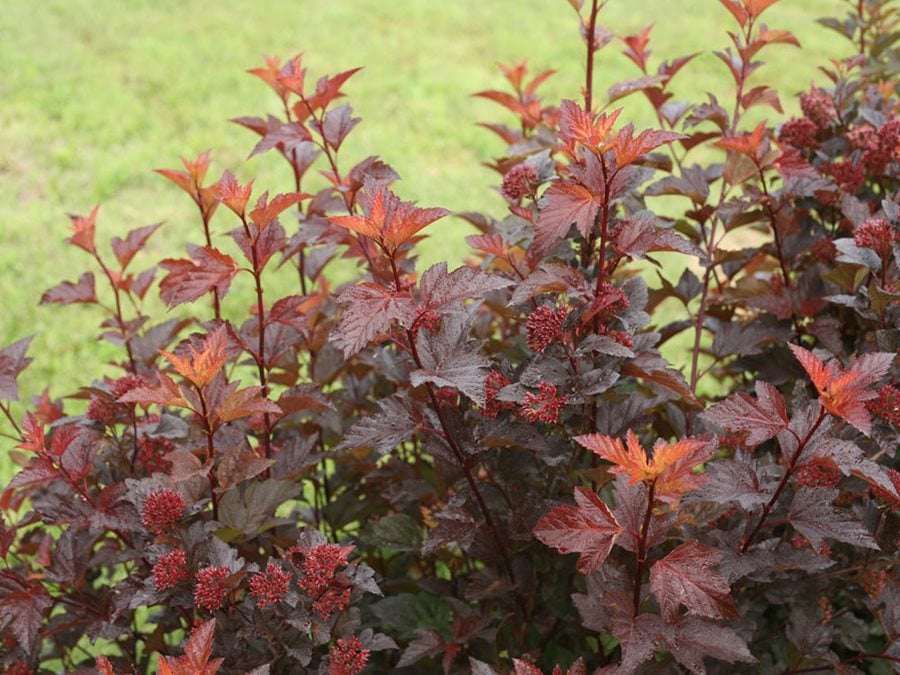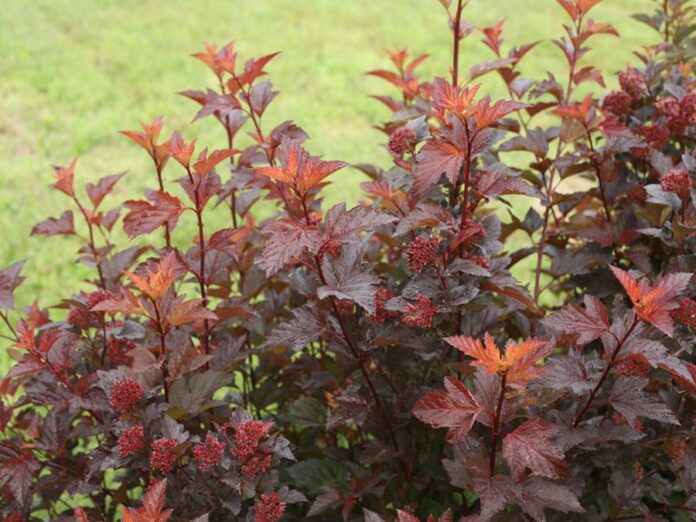[ad_1]
Want to add some color, texture, and height to your landscape? Ninebark shrub is an elegant choice.
Ninebark shrubs are a popular ornamental plant for the home garden because they have many attractive features. This article will discuss what ninebark plants look like, where you can grow ninebark plants, how and o take care of them once planted in your yard or garden area. Read on!
What is Ninebark Shrub?
Common ninebark, also known as Physocarpus opulifolius, is a versatile deciduous flowering shrub widely used in landscaping. It gets its name from the unique exfoliating bark, peeling in thin layers as the branches mature. Ninebark flowers in late spring. They are shrubs with white flowers which sometimes form clusters of pink blooms. They bear red fruits in late summer and autumn that often attracts birds.

Once the leaves have dropped, the bark and structure are revealed, lending beauty to the landscape that lasts all winter long. Related to lilac and spirea, this North American native can be found in its natural habitat growing along stream banks and in moist wooded areas.
In landscaping, ninebark is used for specimen planting, foundation planting, hedges, screens, and to prevent erosion on slopes.
Ninebark Varieties
Physocarpus opulifolius is a member of the rose family, including hawthorns, spirea, and several fruit shrubs and trees. The shrub is found naturally in abundance across the eastern United States, stretching West into the Dakotas and south to northern Florida.
Also, one type is found in the Rocky Mountains and westward to Oregon and Washington. The ninebark shrub comes in several varieties with colored leaves, commonly purple and yellow. Here are those varieties:
Diablo or Monlo
This is an 8-10 foot tall shrub with chocolate burgundy foliage. It flowers in late spring and is hardy in zones 3 through 7.
Little Devil or Donna May
This is a dwarf variety, 3 to 4 feet tall with greenish burgundy foliage. It blooms in early summer and is known to have good resistance to mildew. It’s hardy in zones three through seven.
Center Glow
This is one of the more colorful varieties. It’s a 6 to 8 feet tall shrub with spring flowers of greenish gold that gradually mature to deep burgundy red in summer. It blooms with white flowers in late spring and is hardy in zones 3 to 7.
Dart’s Gold
Dart’s gold is bright yellow in spring, then matures into deep chartreuse in summer. In fall, the leaves develop a tinge of bronze. White flowers appear in late spring. This variety grows 4 to 5 feet tall and is hardy in zones 3 to 7.
Amber Jubilee
This is a 5 to 6-foot shrub with orange, yellow spring leaves that turn yellow in fall. Hardy in zones 2 to 7 flowers with white blooms in late spring.
Planting Ninebark
Dig a hole as deep as the container holding your ninebark, and twice as wide. Plant the shrub so the top of the root ball is exactly at ground level, then fill around the root ball with soil, ensuring there are no air pockets. Poor soil can be amended with organic material before filling in soil. Water well until the plant is established.

Care for Ninebark
Light
Ninebark grows best in full sun but can tolerate partial shade. In the northern part of its growing range, the shrub prefers around six hours of direct light each day, but the farther south it grows, the more it appreciates some afternoon shade.
Soil
Ninebark prefers neutral to slightly acidic soil that is well draining, but it will tolerate slightly alkaline soils. Mulch can help to retain moisture and hold down weeds. As its native habitat includes stream banks, hillsides, and damp thickets, ninebark tolerates clay and loam soil, as well as shallow and rocky soil. Although it prefers evenly moist, well drained soil, it’s adaptable to rocky and clay soils.
Watering
Ninebark will grow in both dry and wet locations. Its water requirements are generally low, but it will handle poor drainage and occasional flooding if necessary. Once established, ninebark is a good drought tolerant shrub for dry areas.
Temperature and Humidity
Ninebark prefers cool weather as its native habitat is at high elevations in the mountains. It is hardy to USDA plant hardiness zone 2 to 7, meaning it can withstand winter temperatures as low as −40 °F (−40 °C). Ninebark is also tolerant to various humidity levels within its recommended hardiness zones.
However, this shrub doesn’t like hot and humid climates, which can cause fungal diseases in the plant, such as powdery mildew.
Fertilizer
Ninebark is not a heavy feeder. Ninebark prefers soil with a pH of 6.5 to 7.0, so adding lime can be useful in acidic soils. Although ninebark doesn’t need fertilizer very often, if the soil isn’t fertile, it will perform better with regular fertilization twice a year during its active growth.
Once you know how to easily make compost and organic plant food for shrubs and trees, use them to fertilize the ninebark. Apply the fertilizer into the soil starting a few inches away from its trunk and out to where its branches end.
Pruning Ninebark
You should prune ninebark at least once a year early in the growing season. The best time to prune the ninebark shrub is in the first few days after it flowers, which happens between the late winter and early summer, depending on your location. Pruning will help maintain its shape, thin out the shrub, and improve air circulation.

Fully one third of the branches can be cut out with each pruning. Focus on older branches, damaged branches, and those that cross and rub. For winter, older shrubs can be radically pruned close to the ground to renew the plant and encourage better leaf and flower growth. Ninebark tends to back well after pruning.
Propagating Ninebark
Woody shrubs can be tricky to propagate and it can take quite a while, but many people find that stem cuttings from ninebark are relatively easy to root. Unlike herbaceous plants, where cuttings must have leaves, with woody plants like ninebark, the cuttings should be taken when the plant is in dormancy.
Other methods of propagating ninebark, such as layering, are bending down one of the flexible branches so a portion is buried in the soil, with the tip of the branch exposed. When secured in place, the buried portion will send out roots from nodes on the branches.
Once the branch has developed ample roots, which can take a full growing season, you can snip it off the mother plant and then dug up the rooted cutting to replant elsewhere.
Common Pests and Diseases
When kept vigorous, ninebark physocarpus can be free on most problems. Fire blight, powdery mildew, and leaf spots may occur but are rarely fatal. You can also prune away the badly damaged branches.
The plants can be susceptible to aphids, which you can control by spraying with water to knock them offor by spraying the shrub with neem oil or another organic spray.
FAQs on Growing and Caring for Ninebark Shrub
Is ninebark native?
The ninebark shrub, physocarpus opulifolius, is native to central and eastern North America.
What does a ninebark bush look like?
Ninebark’s most distinctive feature is its peeling bark. The leaves are also distinctive. They are oval, dark green, and arranged in pairs on the stems.
Are ninebark evergreen?
Ninebark is a deciduous shrub and not an evergreen, which means it loses its leaves during the winter dormancy. However, it’s still among the best evergreen flowering plants to grow in your landscape.
Final Thought on Growing and Caring for Ninebark Shrub
As you can see, growing and caring for ninebark shrubs is easy. However, a word of caution: ninebark is a member of the rose family, and as such, it has thorns. When first planting your ninebark shrub, keep children and pets away from it until the plant becomes more established.
Also, do not walk near it barefoot or with open-toe shoes on, as what you will likely come away with is a nasty thorn in the foot. As an easy fast growing shrub, this plant introduces dark foliage to your landscape and the weeping habit adds variety in shape and texture.
The post How to Grow Ninebark Shrub appeared first on Kitchen Infinity.
[ad_2]
kitcheninfinity.com










